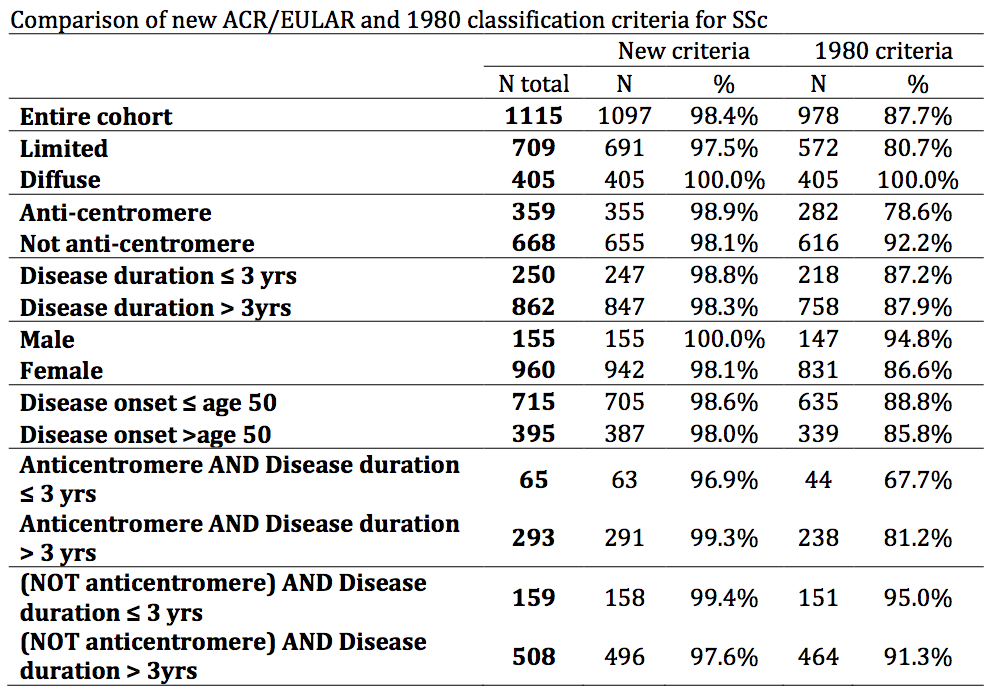Session Information
Title: Systemic Sclerosis, Fibrosing Syndromes, and Raynaud’s - Clinical Aspects and Therapeutics II
Session Type: Abstract Submissions (ACR)
Background/Purpose: New classification criteria for systemic sclerosis (SSc) have recently been developed. In this study, we aimed to assess the sensitivity of this classification in the patients in the Canadian Scleroderma Research Group (CSRG) cohort.
Methods: SSc patients are included in the CSRG cohort if they have a diagnosis of SSc according to a rheumatologist. The 1980 Preliminary Classification Criteria for systemic sclerosis and the new ACR/EULAR classification criteria were applied. The sensitivity of each criterion in diagnosing SSc was calculated and compared across different socio-demographic and clinical categories.
Results: A total of 1115 SSc patients were included in the study. The majority were females (86%). Overall, the sensitivity of the new criteria was higher (98.4%) than that of the 1980 criteria (87.7%). This pattern was consistent among a number of sub-groups. The new criteria detected 691 (97.5%) of the limited SSc patients whereas the 1980 criteria detected only 572 (80.7%) of limited SSc patients. Both criteria detected 100% of patients with diffuse SSc. Ninety nine percent of anti-centromere (ACA) positive patients were detected by the new criteria, whereas the sensitivity of the 1980 criteria was 78.6% in this category. The sensitivities of new and 1980 criteria were 98.1% and 92.2% respectively in negative ACA category. In patients with disease duration ² 3 years, the sensitivity of the new criteria was 98.8% whereas the sensitivity of 1980 criteria was 87.2%. In patients with disease duration > 3 years, the sensitivities of new and 1980 criteria were 98.3% and 87.9% respectively. When we compared the sensitivities according to age at disease onset, we found that the new criteria had a higher sensitivity than the 1980 criteria, 98.6% and 88.8% respectively, for age of onset of ² 50 years and 98% and 85.8% respectively for age of onset > 50 years. The sensitivity of the new criteria were much higher than the 1980 criteria in the ACA positive and disease duration ² 3 years group, 96.9% versus 67.7%, respectively. For patients with disease duration > 3 years and positive ACA, sensitivities were 99.3% versus 81.2% for new and 1980 criteria, respectively. In patients with negative ACA and disease duration ² 3 years, the sensitivity of the new criteria was 99.4% while the sensitivity of 1980 criteria were 95%. Ninety eight percent of patients with negative ACA and disease duration > 3 years were detected using the new criteria, compared with 91.3% for the 1980 criteria in the same group.
Conclusion: Overall, the new classification criteria for SSc are substantially more sensitive than the 1980 criteria. This applies to both sexes, recent or longstanding disease and either young or older subjects. The improvement in sensitivity is most striking, however, in limited SSc or in those with ACA and especially in those with recent onset ACA positive disease.
Disclosure:
H. Alhajeri,
None;
M. Hudson,
None;
M. J. Fritzler,
None;
J. E. Pope,
None;
C. S. R. G. –,
None;
M. Baron,
None.
« Back to 2013 ACR/ARHP Annual Meeting
ACR Meeting Abstracts - https://acrabstracts.org/abstract/evaluation-of-the-new-american-college-of-rheumatologyeuropean-league-against-rheumatism-criteria-for-the-classification-of-systemic-sclerosis-in-the-canadian-scleroderma-research-group-cohort/

